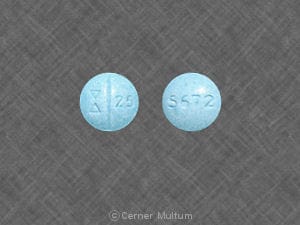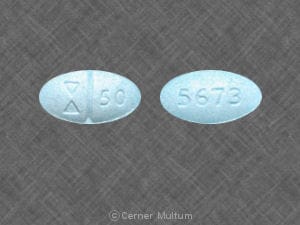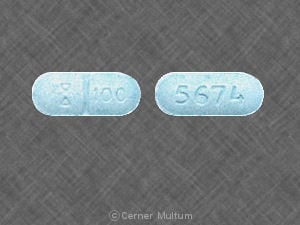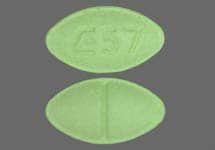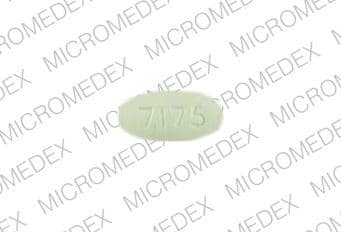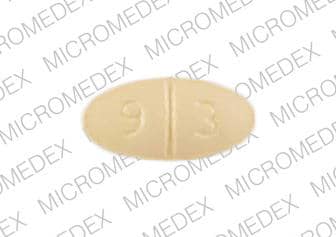Boxed Warning
Suicidality and antidepressant drugs:
Antidepressants increased the risk of suicidal thoughts and behavior in pediatric and young adult patients in short-term studies. Closely monitor all antidepressant-treated patients for clinical worsening, and for emergence of suicidal thoughts and behaviors.
Dosage Forms
Excipient information presented when available (limited, particularly for generics); consult specific product labeling.
Concentrate, Oral:
Zoloft: 20 mg/mL (60 mL) [contains alcohol, usp, menthol]
Generic: 20 mg/mL (60 mL)
Tablet, Oral:
Zoloft: 25 mg [scored; contains fd&c blue #1 aluminum lake, fd&c red #40 aluminum lake, fd&c yellow #10 aluminum lake, polysorbate 80]
Zoloft: 50 mg [scored; contains fd&c blue #2 aluminum lake]
Zoloft: 100 mg [scored; contains polysorbate 80]
Generic: 25 mg, 50 mg, 100 mg
Pharmacology
Mechanism of Action
Antidepressant with selective inhibitory effects on presynaptic serotonin (5-HT) reuptake and only very weak effects on norepinephrine and dopamine neuronal uptake. In vitro studies demonstrate no significant affinity for adrenergic, cholinergic, GABA, dopaminergic, histaminergic, serotonergic, or benzodiazepine receptors.
Pharmacokinetics/Pharmacodynamics
Metabolism
Hepatic; may involve CYP2C19 and CYP2D6; extensive first pass metabolism; forms metabolite N-desmethylsertraline (APA [Gelenberg 2010]); Note: Children 6 to 17 years may metabolize sertraline slightly better than adults, as pediatric AUCs and peak concentrations were 22% lower than adults when adjusted for weight; however, lower doses are recommended for younger pediatric patients to avoid excessive drug levels)
Excretion
Urine (40% to 45% as metabolites); feces (40% to 45%; 12% to 14% as unchanged drug)
Onset of Action
Depression: The onset of action is within a week, however, individual response varies greatly and full response may not be seen until 8 to 12 weeks after initiation of treatment (APA [Gelenberg 2010]).
Time to Peak
Plasma: Sertraline: 4.5 to 8.4 hours
Half-Life Elimination
Sertraline: Mean: 26 hours; N-desmethylsertraline: 62 to 104 hours
Children 6 to 12 years: Mean: 26.2 hours (Alderman 1998)
Children 13 to 17 years: Mean: 27.8 hours (Alderman 1998)
Adults 18 to 45 years: Mean: 27.2 hours (Alderman 1998)
Protein Binding
98%
Use in Specific Populations
Special Populations: Hepatic Function Impairment
Sertraline clearance was reduced in patients with chronic mild liver impairment resulting in a 3-fold greater exposure.
Special Populations: Elderly
Plasma clearance 40% lower; steady state achieved after 2 to 3 weeks
Special Populations: Children
Children 6 to 17 years may metabolize sertraline slightly better than adults, as pediatric AUCs and peak concentrations were 22% lower than adults when adjusted for weight; however, lower doses are recommended for younger pediatric patients to avoid excessive drug levels)
Use: Labeled Indications
Major depressive disorder (unipolar): Treatment of unipolar major depressive disorder (MDD) in adults.
Obsessive-compulsive disorder: Treatment of obsessions and compulsions in patients with obsessive-compulsive disorder (OCD).
Panic disorder: Treatment of panic disorder in adults with or without agoraphobia.
Posttraumatic stress disorder: Treatment of posttraumatic stress disorder (PTSD) in adults.
Premenstrual dysphoric disorder: Treatment of premenstrual dysphoric disorder (PMDD) in adults.
Social anxiety disorder: Treatment of social anxiety disorder (social phobia) in adults.
Use: Off Label
Binge eating disorderbyes
Data from two small, double-blind, randomized, controlled trials support the use of sertraline to improve weight loss, binge frequency, and binge behaviors in patients with binge eating disorder Leombruni 2008, McElroy 2000.
Based on the World Federation of Societies of Biological Psychiatry guidelines for the pharmacological treatment of eating disorders, sertraline may be effective and is recommended in the management of binge eating disorder WFSBP [Aigner 2011].
Body dysmorphic disorderyes
Based on the National Institute for Health and Care Excellence (NICE) guidelines for treatment of obsessive-compulsive disorder and body dysmorphic disorder, SSRIs given as monotherapy or in combination with cognitive behavior therapy are recommended in the management of body dysmorphic disorder in adults with moderate or severe functional impairment, respectively.
Bulimia nervosab
Data from one small, randomized, controlled trial and another study of lower quality (open-label, flexible-dose study) in patients with bulimia nervosa support the use of sertraline to reduce the number of binge eating crises and purging in these patients Milano 2004, Sloan 2004.
Generalized anxiety disorderayes
Data from several double-blind, randomized, controlled trials in patients with generalized anxiety disorder, support the use of sertraline to reduce anxiety symptoms in these patients Ball 2005, Brawman-Mintzer 2006, Dahl 2005.
Based on the World Federation of Societies of Biological Psychiatry guidelines for the pharmacological treatment of anxiety disorders, sertraline is effective and recommended in the management of generalized anxiety disorder WFSBP [Bandelow 2008], WFSBP [Bandelow 2012].
Premature ejaculationbyes
Data from randomized controlled trials suggest that sertraline may be beneficial for the treatment of premature ejaculation Arafa 2006, McMahon 1998a, Mendels 1995.
According to the
Contraindications
Use of MAOIs including linezolid or methylene blue (concurrently or within 14 days of stopping an MAOI or sertraline); concurrent use with pimozide; hypersensitivity (eg, anaphylaxis, angioedema) to sertraline or any component of the formulation; concurrent use with disulfiram (oral solution only).
Documentation of allergenic cross-reactivity for SSRIs is limited. However, because of similarities in chemical structure and/or pharmacologic actions, the possibility of cross-sensitivity cannot be ruled out with certainty.
Dosage and Administration
Dosing: Adult
Note: In patients sensitive to side effects, some experts suggest a lower starting dose of 12.5 to 25 mg daily and gradual titration in increments of no more than 25 mg, particularly in patients with anxiety who are generally more sensitive to overstimulation effects (eg, anxiety, insomnia) with antidepressants (Hirsch 2018a; Stein 2018; WFSBP [Bandelow 2012]).
Binge eating disorder (off-label use): Based on limited data: Oral: Initial: 25 mg once daily after lunch; may increase dose based on response and tolerability in increments of 25 mg every 3 days. Usual dose range: 100 to 200 mg daily. Maximum dose: 200 mg/day (Leombruni 2008). Based on limited data, some experts recommend doses used for major depressive disorder and slower titrations (eg, ≥1 week) (Sysko 2018).
Body dysmorphic disorder (BDD) (off-label use): Based on limited data: Oral: Some experts suggest an initial dose of 50 mg once daily; may increase dose gradually based on response and tolerability in increments of 25 to 50 mg at intervals of every 2 to 3 weeks to a usual dose of 200 mg/day; doses up to 400 mg/day may be necessary in some patients for optimal response (Phillips 2019). Note: An adequate trial for assessment of effect in BDD is 12 to 16 weeks, including maximum tolerated doses for at least 3 to 4 of those weeks (Phillips 2019).
Bulimia nervosa (alternative agent) (off-label use): Oral: Initial: 50 mg daily; may increase dose based on response and tolerability in increments of 50 mg at intervals ≥1 week (Milano 2004; Sloan 2004). Maximum dose: 300 mg/day (Crow 2019).
Generalized anxiety disorder (GAD) (off-label use): Oral: Initial: 25 mg once daily; may increase dose based on response and tolerability in increments of 25 to 50 mg at intervals ≥1 to 2 weeks. Usual dose: 50 to 150 mg/day. Maximum dose: 200 mg/day (Ball 2005; Brawman-Mintzer 2006; Dahl 2005).
Major depressive disorder (MDD) (unipolar): Oral: Initial: 50 mg once daily; may increase dose based on response and tolerability in increments of 25 to 50 mg once weekly to a maximum of 200 mg/day (according to manufacturer's labeling); however, doses up to 300 mg/day have been used in clinical practice for MDD and may provide further benefit (Simon 2018). More rapid titrations (every 3 days) in combination with an antipsychotic (eg, olanzapine) are used by some experts for patients with psychotic features (Meyers 2009; Rothschild 2018).
Obsessive-compulsive disorder: Oral: Initial: 50 mg once daily; may increase dose based on response and tolerability in increments of 25 to 50 mg once weekly to a maximum of 200 mg/day (according to the manufacturer's labeling). Doses up to 400 mg/day may have modest clinical benefit in patients with inadequate response to standard doses (Ninan 2006), but adverse effects may be increased.
Panic disorder: Oral: Initial: 25 mg once daily for 3 to 7 days, then increase to 50 mg/day (APA 2009); thereafter, may increase dose based on response and tolerability in increments of 25 to 50 mg at intervals ≥1 week to a maximum of 200 mg/day
Posttraumatic stress disorder (PTSD): Oral: Initial: 25 to 50 mg once daily (VA/DoD 2017); may increase dose based on response and tolerability in increments of 25 to 50 mg at intervals ≥1 week to a maximum of 200 mg/day (according to the manufacturer's labeling); however, doses up to 250 mg/day have been used in clinical practice and may provide further benefit (Stein 2018).
Premature ejaculation (off-label use): Oral: Initial: 50 mg once daily; may increase dose based on response and tolerability at intervals of ~3 to 4 weeks in 50 mg increments up to 200 mg/day (McMahon 1998b; Mendels 1995)
Premenstrual dysphoric disorder (PMDD):
Continuous daily dosing regimen: Oral: Initial: 25 mg once daily; over the first month, increase to the usual effective dose of 50 mg once daily; in subsequent menstrual cycles, further increases in dose (eg, in 50 mg increments per menstrual cycle) up to 200 mg/day may be necessary in some patients for optimal response (Casper 2019).
Intermittent regimens:
Luteal phase dosing regimen: Oral: Initial: 25 mg once daily during the luteal phase of menstrual cycle only (ie, beginning therapy 14 days before anticipated onset of menstruation and continued to the onset of menses); over the first month, increase to the usual effective dose of 50 mg/day; in subsequent menstrual cycles, further increases in dose (eg, in 50 mg increments per menstrual cycle) up to 150 mg/day during the luteal phase may be necessary in some patients for optimal response (Casper 2019).
Symptom-onset dosing regimen (off-label dosing): Oral: Initial: 25 mg once daily from the day of symptom onset until a few days after the start of menses; over the first month, increase to the usual effective dose of 50 mg/day; in subsequent menstrual cycles, further increases in dose (eg, in 50 mg increments per menstrual cycle) up to 150 mg/day may be necessary for some patients for optimal response (Casper 2019).
Note: If a daily dose ≥100 mg was established in previous cycles, may begin with 50 mg once daily for 2 to 3 days in subsequent cycles, then increase to previously established dose (Yonkers 2015; manufacturer's labeling).
Social anxiety disorder: Oral: Initial: 25 to 50 mg once daily (WFSBP [Bandelow 2012]); after ~6 weeks, may increase dose based on response and tolerability in increments of 25 to 50 mg at intervals ≥1 week to a maximum of 200 mg/day (according to the manufacturer's labeling); however, doses up to 250 mg/day have been used in clinical practice and may provide further benefit (Stein 2019).
Discontinuation of therapy: When discontinuing antidepressant treatment that has lasted for >3 weeks, gradually taper the dose (eg, over 2 to 4 weeks) to minimize withdrawal symptoms and detect reemerging symptoms (APA 2010; WFSBP [Bauer 2015]). Reasons for a slower titration (eg, over 4 weeks) include use of a drug with a half-life <24 hours (eg, paroxetine, venlafaxine), prior history of antidepressant withdrawal symptoms, or high doses of antidepressants (APA 2010; Hirsch 2019). If intolerable withdrawal symptoms occur, resume the previously prescribed dose and/or decrease dose at a more gradual rate (Shelton 2001). Select patients (eg, those with a history of discontinuation syndrome) on long-term treatment (>6 months) may benefit from tapering over >3 months (WFSBP [Bauer 2015]). Evidence supporting ideal taper rates is limited (Shelton 2001; WFSBP [Bauer 2015]).
Switching antidepressants: Evidence for ideal antidepressant switching strategies is limited; strategies include cross-titration (gradually discontinuing the first antidepressant while at the same time gradually increasing the new antidepressant) and direct switch (abruptly discontinuing the first antidepressant and then starting the new antidepressant at an equivalent dose or lower dose and increasing it gradually). Cross-titration (eg, over 1 to 4 weeks depending upon sensitivity to discontinuation symptoms and adverse effects) is standard for most switches, but is contraindicated when switching to or from an MAOI. A direct switch may be an appropriate approach when switching to another agent in the same or similar class (eg, when switching between two SSRIs), when the antidepressant to be discontinued has been used for <1 week, or when the discontinuation is for adverse effects. When choosing the switch strategy, consider the risk of discontinuation symptoms, potential for drug interactions, other antidepressant properties (eg, half-life, adverse effects, and pharmacodynamics), and the degree of symptom control desired (Hirsch 2018b; Ogle 2013; WFSBP [Bauer 2013]).
Switching to or from an MAOI:
Allow 14 days to elapse between discontinuing an MAOI and initiation of sertraline.
Allow 14 days to elapse between discontinuing sertraline and initiation of an MAOI.
Dosing: Geriatric
Refer to adult dosing; however, lower initial doses (25 mg once daily) may be better tolerated in older adults (Hirsch 2018a).
Discontinuation of therapy: Refer to adult dosing.
Switching antidepressants: Refer to adult dosing.
Dosing: Pediatric
Depression: Limited data available: Oral:
Children 6 to 12 years: Initial: 12.5 to 25 mg once daily; titrate dose upwards if clinically needed; may increase by 25 to 50 mg/day increments at intervals of at least 1 week; mean final dose in 21 children (8 to 18 years of age) was 100 ± 53 mg or 1.6 mg/kg/day (n=11); range: 25 to 200 mg/day; maximum daily dose: 200 mg/day (Dopheide 2006; Tierney 1995); avoid excessive dosing
Adolescents 13 to 17 years: Initial: 25 to 50 mg once daily; titrate dose upwards if clinically needed; may increase by 50 mg/day increments at intervals of at least 1 week; mean final dose in 13 adolescents was 110 ± 50 mg or about 2 mg/kg/day (McConville 1996); in another study using a slower titration, the mean dose at week 6 was 93 mg (n=41) and at week 10 was 127 mg (n=34) (Ambrosini 1999); range: 25 to 200 mg/day; maximum daily dose: 200 mg/day (Dopheide 2006).
Obsessive-compulsive disorder: Oral:
Children 6 to 12 years: Initial: 25 mg once daily; titrate dose upwards if clinically needed; increase by 25 to 50 mg/day increments at intervals of at least 1 week; range: 25 to 200 mg/day; maximum daily dose: 200 mg/day; avoid excessive dosing
Adolescents 13 to 17 years: Initial: 50 mg once daily; titrate dose upwards if clinically needed; increase by 50 mg/day increments at intervals of at least 1 week; range: 25 to 200 mg/day; maximum daily dose: 200 mg/day
Discontinuation of therapy: Consider planning antidepressant discontinuation for lower-stress times, recognizing non-illness-related factors could cause stress or anxiety and be misattributed to antidepressant discontinuation (Hathaway 2018). Upon discontinuation of antidepressant therapy, gradually taper the dose to minimize the incidence of discontinuation syndromes (withdrawal) and allow for the detection of reemerging disease state symptoms (eg, relapse). Evidence supporting ideal taper rates after illness remission is limited. APA and NICE guidelines suggest tapering therapy over at least several weeks with consideration to the half-life of the antidepressant; antidepressants with a shorter half-life may need to be tapered more conservatively. After long-term (years) antidepressant treatment, WFSBP guidelines recommend tapering over 4 to 6 months, with close monitoring during and for 6 months after discontinuation. If intolerable discontinuation symptoms occur following a dose reduction, consider resuming the previously prescribed dose and/or decrease dose at a more gradual rate (APA 2010; Bauer 2002; Fenske 2009; Haddad 2001; NCCMH 2010; Schatzberg 2006; Shelton 2001; Warner 2006).
MAO inhibitor recommendations:
Switching to or from an MAO inhibitor intended to treat psychiatric disorders:
Allow 14 days to elapse between discontinuing an MAO inhibitor intended to treat psychiatric disorders and initiation of sertraline.
Allow 14 days to elapse between discontinuing sertraline and initiation of an MAO inhibitor intended to treat psychiatric disorders.
Reconstitution
Oral solution: Must be diluted before use. Immediately before administration, use the dropper provided to measure the required amount of solution; mix with 4 ounces (1/2 cup) of water, ginger ale, lemon/lime soda, lemonade, or orange juice only. Do not mix with any other liquids than these. The dose should be taken immediately after mixing; do not mix in advance. A slight haze may appear after mixing; this is normal.
Administration
Oral solution: Must be diluted immediately before use to make the preparation more palatable. Direct administration of the pure solution is astringent and may numb the tongue/mouth for at least a day, even if the mouth is rinsed extensively (Pfizer Medical Information, written communication, February 2, 2016). Note: Use with caution in patients with latex sensitivity; dropper dispenser contains dry natural rubber.
Storage
Store at 20°C to 25°C (68°F to 77°F); excursions permitted to 15°C to 30°C (59°F to 86°F).
Sertraline Images
Drug Interactions
Acalabrutinib: May enhance the antiplatelet effect of Agents with Antiplatelet Properties. Monitor therapy
Agents with Antiplatelet Properties (e.g., P2Y12 inhibitors, NSAIDs, SSRIs, etc.): May enhance the antiplatelet effect of other Agents with Antiplatelet Properties. Monitor therapy
Alcohol (Ethyl): May enhance the adverse/toxic effect of Selective Serotonin Reuptake Inhibitors. Specifically, the risk of psychomotor impairment may be enhanced. Management: Patients receiving selective serotonin reuptake inhibitors should be advised to avoid alcohol. Monitor for increased psychomotor impairment in patients who consume alcohol during treatment with selective serotonin reuptake inhibitors. Consider therapy modification
Almotriptan: May enhance the serotonergic effect of Serotonergic Agents (High Risk). This could result in serotonin syndrome. Management: Monitor for signs and symptoms of serotonin syndrome/serotonin toxicity (eg, hyperreflexia, clonus, hyperthermia, diaphoresis, tremor, autonomic instability, mental status changes) when these agents are combined. Monitor therapy
Alosetron: May enhance the serotonergic effect of Serotonergic Agents (High Risk). This could result in serotonin syndrome. Management: Monitor for signs and symptoms of serotonin syndrome/serotonin toxicity (eg, hyperreflexia, clonus, hyperthermia, diaphoresis, tremor, autonomic instability, mental status changes) when these agents are combined. Monitor therapy
Amphetamines: May enhance the serotonergic effect of Serotonergic Agents (High Risk). This could result in serotonin syndrome. Management: Monitor for signs and symptoms of serotonin syndrome/serotonin toxicity (eg, hyperreflexia, clonus, hyperthermia, diaphoresis, tremor, autonomic instability, mental status changes) when these agents are combined. Monitor therapy
Anticoagulants: Agents with Antiplatelet Properties may enhance the anticoagulant effect of Anticoagulants. Exceptions: Bemiparin; Enoxaparin; Heparin. Monitor therapy
Antiemetics (5HT3 Antagonists): May enhance the serotonergic effect of Serotonergic Agents (High Risk). This could result in serotonin syndrome. Management: Monitor for signs and symptoms of serotonin syndrome/serotonin toxicity (eg, hyperreflexia, clonus, hyperthermia, diaphoresis, tremor, autonomic instability, mental status changes) when these agents are combined. Exceptions: Alosetron; Ondansetron; Ramosetron. Monitor therapy
Antipsychotic Agents: Serotonergic Agents (High Risk) may enhance the adverse/toxic effect of Antipsychotic Agents. Specifically, serotonergic agents may enhance dopamine blockade, possibly increasing the risk for neuroleptic malignant syndrome. Antipsychotic Agents may enhance the serotonergic effect of Serotonergic Agents (High Risk). This could result in serotonin syndrome. Monitor therapy
Apixaban: Agents with Antiplatelet Properties may enhance the adverse/toxic effect of Apixaban. Specifically, the risk for bleeding may be increased. Management: Carefully consider risks and benefits of this combination and monitor closely. Monitor therapy
ARIPiprazole: Sertraline may enhance the adverse/toxic effect of ARIPiprazole. Sertraline may increase the serum concentration of ARIPiprazole. Monitor therapy
Aspirin: Selective Serotonin Reuptake Inhibitors may enhance the antiplatelet effect of Aspirin. Monitor therapy
Bemiparin: Agents with Antiplatelet Properties may enhance the anticoagulant effect of Bemiparin. Management: Avoid concomitant use of bemiparin with antiplatelet agents. If concomitant use is unavoidable, monitor closely for signs and symptoms of bleeding. Consider therapy modification
Beta-Blockers: Selective Serotonin Reuptake Inhibitors may increase the serum concentration of Beta-Blockers. Exceptions: Acebutolol; Atenolol; Betaxolol (Ophthalmic); Betaxolol (Systemic); Bisoprolol; Carteolol (Ophthalmic); Esmolol; Labetalol; Levobunolol; Metipranolol; Nadolol; Sotalol. Monitor therapy
Blood Glucose Lowering Agents: Selective Serotonin Reuptake Inhibitors may enhance the hypoglycemic effect of Blood Glucose Lowering Agents. Monitor therapy
Brexanolone: Selective Serotonin Reuptake Inhibitors may enhance the CNS depressant effect of Brexanolone. Monitor therapy
Bromopride: May enhance the adverse/toxic effect of Selective Serotonin Reuptake Inhibitors. Avoid combination
BuPROPion: May enhance the adverse/toxic effect of Sertraline. Specifically, the risk for seizures and serotonin syndrome may be increased. Monitor therapy
BusPIRone: May enhance the serotonergic effect of Serotonergic Agents (High Risk). This could result in serotonin syndrome. Management: Monitor for signs and symptoms of serotonin syndrome/serotonin toxicity (eg, hyperreflexia, clonus, hyperthermia, diaphoresis, tremor, autonomic instability, mental status changes) when these agents are combined. Monitor therapy
CarBAMazepine: May decrease the serum concentration of Sertraline. Monitor therapy
Cephalothin: Agents with Antiplatelet Properties may enhance the adverse/toxic effect of Cephalothin. Specifically, the risk for bleeding may be increased. Monitor therapy
Citalopram: May enhance the antiplatelet effect of Selective Serotonin Reuptake Inhibitors. Citalopram may enhance the serotonergic effect of Selective Serotonin Reuptake Inhibitors. This could result in serotonin syndrome. Management: Monitor for signs and symptoms of serotonin syndrome/serotonin toxicity (eg, hyperreflexia, clonus, hyperthermia, diaphoresis, tremor, mental status changes) when these agents are combined. In addition, monitor for signs and symptoms of bleeding. Monitor therapy
CNS Depressants: May enhance the adverse/toxic effect of Selective Serotonin Reuptake Inhibitors. Specifically, the risk of psychomotor impairment may be enhanced. Monitor therapy
Collagenase (Systemic): Agents with Antiplatelet Properties may enhance the adverse/toxic effect of Collagenase (Systemic). Specifically, the risk of injection site bruising and/or bleeding may be increased. Monitor therapy
Cyclobenzaprine: May enhance the serotonergic effect of Serotonergic Agents (High Risk). This could result in serotonin syndrome. Management: Monitor for signs and symptoms of serotonin syndrome/serotonin toxicity (eg, hyperreflexia, clonus, hyperthermia, diaphoresis, tremor, autonomic instability, mental status changes) when these agents are combined. Monitor therapy
CYP3A4 Inducers (Strong): May decrease the serum concentration of Sertraline. Monitor therapy
Cyproheptadine: May diminish the therapeutic effect of Selective Serotonin Reuptake Inhibitors. Monitor therapy
Dabigatran Etexilate: Agents with Antiplatelet Properties may enhance the anticoagulant effect of Dabigatran Etexilate. Agents with Antiplatelet Properties may increase the serum concentration of Dabigatran Etexilate. This mechanism applies specifically to clopidogrel. Management: Carefully consider risks and benefits of this combination and monitor closely; Canadian labeling recommends avoiding prasugrel or ticagrelor. Monitor therapy
Dapoxetine: May enhance the serotonergic effect of Serotonergic Agents (High Risk). This could result in serotonin syndrome. Management: Do not use serotonergic agents (high risk) with dapoxetine or within 7 days of serotonergic agent discontinuation. Do not use dapoxetine within 14 days of monoamine oxidase inhibitor use. Dapoxetine labeling lists this combination as contraindicated. Avoid combination
Darunavir: May decrease the serum concentration of Sertraline. Monitor therapy
Dasatinib: May enhance the anticoagulant effect of Agents with Antiplatelet Properties. Management: Drugs listed as exceptions to this monograph are discussed in further detail in separate drug interaction monographs. Monitor therapy
Deoxycholic Acid: Agents with Antiplatelet Properties may enhance the adverse/toxic effect of Deoxycholic Acid. Specifically, the risk for bleeding or bruising in the treatment area may be increased. Monitor therapy
Desmopressin: Selective Serotonin Reuptake Inhibitors may enhance the adverse/toxic effect of Desmopressin. Monitor therapy
Dexmethylphenidate-Methylphenidate: May enhance the serotonergic effect of Serotonergic Agents (High Risk). This could result in serotonin syndrome. Management: Monitor for signs and symptoms of serotonin syndrome/serotonin toxicity (eg, hyperreflexia, clonus, hyperthermia, diaphoresis, tremor, autonomic instability, mental status changes) when these agents are combined. Monitor therapy
Dextromethorphan: May enhance the serotonergic effect of Serotonergic Agents (High Risk). This could result in serotonin syndrome. Management: Monitor for signs and symptoms of serotonin syndrome/serotonin toxicity (eg, hyperreflexia, clonus, hyperthermia, diaphoresis, tremor, autonomic instability, mental status changes) when these agents are combined. Monitor therapy
Disulfiram: May enhance the adverse/toxic effect of Sertraline. This is specifically related to sertraline oral concentrate due to its alcohol content (12%). Management: Sertraline Oral Concentrate contains 12% alcohol, and its use should be avoided with disulfiram. Avoid combination
DULoxetine: Selective Serotonin Reuptake Inhibitors may enhance the antiplatelet effect of DULoxetine. Selective Serotonin Reuptake Inhibitors may enhance the serotonergic effect of DULoxetine. This could result in serotonin syndrome. Management: Monitor for signs and symptoms of serotonin syndrome/serotonin toxicity (eg, hyperreflexia, clonus, hyperthermia, diaphoresis, tremor, mental status changes) when these agents are combined. In addition, monitor for signs and symptoms of bleeding. Monitor therapy
Edoxaban: Agents with Antiplatelet Properties may enhance the adverse/toxic effect of Edoxaban. Specifically, the risk of bleeding may be increased. Monitor therapy
Efavirenz: May decrease the serum concentration of Sertraline. Monitor therapy
Eletriptan: May enhance the serotonergic effect of Serotonergic Agents (High Risk). This could result in serotonin syndrome. Management: Monitor for signs and symptoms of serotonin syndrome/serotonin toxicity (eg, hyperreflexia, clonus, hyperthermia, diaphoresis, tremor, autonomic instability, mental status changes) when these agents are combined. Monitor therapy
Enoxaparin: Agents with Antiplatelet Properties may enhance the anticoagulant effect of Enoxaparin. Management: Discontinue antiplatelet agents prior to initiating enoxaparin whenever possible. If concomitant administration is unavoidable, monitor closely for signs and symptoms of bleeding. Consider therapy modification
Ergot Derivatives: May enhance the serotonergic effect of Serotonergic Agents (High Risk). This could result in serotonin syndrome. Management: Monitor for signs and symptoms of serotonin syndrome/serotonin toxicity (eg, hyperreflexia, clonus, hyperthermia, diaphoresis, tremor, autonomic instability, mental status changes) when these agents are combined. Exceptions: Nicergoline. Monitor therapy
Erythromycin (Systemic): May enhance the adverse/toxic effect of Sertraline. Monitor therapy
Fat Emulsion (Fish Oil Based): May enhance the adverse/toxic effect of Agents with Antiplatelet Properties. Monitor therapy
Fosphenytoin: May decrease the serum concentration of Sertraline. Sertraline may increase the serum concentration of Fosphenytoin. Monitor therapy
Gilteritinib: May diminish the therapeutic effect of Selective Serotonin Reuptake Inhibitors. Management: Avoid use of this combination if possible. If the combination cannot be avoided, monitor closely for evidence of reduced response to the selective serotonin reuptake inhibitor. Consider therapy modification
Glucosamine: May enhance the antiplatelet effect of Agents with Antiplatelet Properties. Monitor therapy
Grapefruit Juice: May increase the serum concentration of Sertraline. Monitor therapy
Haloperidol: QT-prolonging Agents (Indeterminate Risk - Caution) may enhance the QTc-prolonging effect of Haloperidol. Monitor therapy
Heparin: Agents with Antiplatelet Properties may enhance the anticoagulant effect of Heparin. Management: Decrease the dose of heparin or agents with antiplatelet properties if coadministration is required. Consider therapy modification
Herbs (Anticoagulant/Antiplatelet Properties) (eg, Alfalfa, Anise, Bilberry): May enhance the adverse/toxic effect of Agents with Antiplatelet Properties. Bleeding may occur. Management: Avoid combination when possible. If used, monitor more closely for evidence of bleeding. Discontinue herbal products with anticoagulant or antiplatelet actions 2 weeks prior to surgical, dental, or invasive procedures. Consider therapy modification
Ibritumomab Tiuxetan: Agents with Antiplatelet Properties may enhance the adverse/toxic effect of Ibritumomab Tiuxetan. Both agents may contribute to impaired platelet function and an increased risk of bleeding. Monitor therapy
Ibrutinib: May enhance the adverse/toxic effect of Agents with Antiplatelet Properties. Monitor therapy
Inotersen: May enhance the antiplatelet effect of Agents with Antiplatelet Properties. Monitor therapy
Ioflupane I 123: Selective Serotonin Reuptake Inhibitors may diminish the diagnostic effect of Ioflupane I 123. Monitor therapy
Lasmiditan: May enhance the serotonergic effect of Serotonergic Agents (High Risk). This could result in serotonin syndrome. Management: Monitor for signs and symptoms of serotonin syndrome/serotonin toxicity (eg, hyperreflexia, clonus, hyperthermia, diaphoresis, tremor, autonomic instability, mental status changes) when these agents are combined. Monitor therapy
Limaprost: May enhance the antiplatelet effect of Agents with Antiplatelet Properties. Monitor therapy
Linezolid: May enhance the serotonergic effect of Selective Serotonin Reuptake Inhibitors. This could result in serotonin syndrome. Avoid combination
Lorcaserin: May enhance the serotonergic effect of Serotonergic Agents (High Risk). This could result in serotonin syndrome. Management: Monitor for signs and symptoms of serotonin syndrome/serotonin toxicity (eg, hyperreflexia, clonus, hyperthermia, diaphoresis, tremor, autonomic instability, mental status changes) when these agents are combined. Monitor therapy
Metaxalone: May enhance the serotonergic effect of Serotonergic Agents (High Risk). This could result in serotonin syndrome. Management: Monitor for signs and symptoms of serotonin syndrome/serotonin toxicity (eg, hyperreflexia, clonus, hyperthermia, diaphoresis, tremor, autonomic instability, mental status changes) when these agents are combined. Monitor therapy
Methylene Blue: Selective Serotonin Reuptake Inhibitors may enhance the serotonergic effect of Methylene Blue. This could result in serotonin syndrome. Avoid combination
Metoclopramide: May enhance the adverse/toxic effect of Selective Serotonin Reuptake Inhibitors. Management: Seek alternatives to this combination when possible. Monitor patients receiving metoclopramide with selective serotonin reuptake inhibitors for signs of extrapyramidal symptoms, neuroleptic malignant syndrome, and serotonin syndrome. Consider therapy modification
MetyroSINE: May enhance the adverse/toxic effect of Selective Serotonin Reuptake Inhibitors. Monitor therapy
Mivacurium: Sertraline may increase the serum concentration of Mivacurium. Monitor therapy
Monoamine Oxidase Inhibitors (Antidepressant): Selective Serotonin Reuptake Inhibitors may enhance the serotonergic effect of Monoamine Oxidase Inhibitors (Antidepressant). This could result in serotonin syndrome. Avoid combination
Multivitamins/Fluoride (with ADE): May enhance the antiplatelet effect of Agents with Antiplatelet Properties. Monitor therapy
Multivitamins/Minerals (with ADEK, Folate, Iron): May enhance the antiplatelet effect of Agents with Antiplatelet Properties. Monitor therapy
Multivitamins/Minerals (with AE, No Iron): May enhance the antiplatelet effect of Agents with Antiplatelet Properties. Monitor therapy
Nefazodone: May enhance the serotonergic effect of Selective Serotonin Reuptake Inhibitors. This could result in serotonin syndrome. Management: Monitor for signs and symptoms of serotonin syndrome/serotonin toxicity (eg, hyperreflexia, clonus, hyperthermia, diaphoresis, tremor, autonomic instability, mental status changes) when these agents are combined. Monitor therapy
Nonsteroidal Anti-Inflammatory Agents (COX-2 Selective): Selective Serotonin Reuptake Inhibitors may enhance the antiplatelet effect of Nonsteroidal Anti-Inflammatory Agents (COX-2 Selective). Nonsteroidal Anti-Inflammatory Agents (COX-2 Selective) may diminish the therapeutic effect of Selective Serotonin Reuptake Inhibitors. Monitor therapy
Nonsteroidal Anti-Inflammatory Agents (Nonselective): Selective Serotonin Reuptake Inhibitors may enhance the antiplatelet effect of Nonsteroidal Anti-Inflammatory Agents (Nonselective). Nonsteroidal Anti-Inflammatory Agents (Nonselective) may diminish the therapeutic effect of Selective Serotonin Reuptake Inhibitors. Management: Consider alternatives to NSAIDs. Monitor for evidence of bleeding and diminished antidepressant effects. It is unclear whether COX-2-selective NSAIDs reduce risk. Exceptions: Diclofenac (Topical); Ibuprofen (Topical); Piroxicam (Topical). Consider therapy modification
Nonsteroidal Anti-Inflammatory Agents (Topical): May enhance the antiplatelet effect of Selective Serotonin Reuptake Inhibitors. Monitor therapy
Obinutuzumab: Agents with Antiplatelet Properties may enhance the adverse/toxic effect of Obinutuzumab. Specifically, the risk of serious bleeding-related events may be increased. Monitor therapy
Omega-3 Fatty Acids: May enhance the antiplatelet effect of Agents with Antiplatelet Properties. Monitor therapy
Ondansetron: May enhance the serotonergic effect of Serotonergic Agents (High Risk). This could result in serotonin syndrome. Management: Monitor for signs and symptoms of serotonin syndrome/serotonin toxicity (eg, hyperreflexia, clonus, hyperthermia, diaphoresis, tremor, autonomic instability, mental status changes) when these agents are combined. Monitor therapy
Opioid Agonists: May enhance the serotonergic effect of Serotonergic Agents (High Risk). This could result in serotonin syndrome. Management: Monitor for signs and symptoms of serotonin syndrome/serotonin toxicity (eg, hyperreflexia, clonus, hyperthermia, diaphoresis, tremor, autonomic instability, mental status changes) when these agents are combined. Exceptions: FentaNYL; Meperidine; TraMADol. Monitor therapy
Oxitriptan: Serotonergic Agents (High Risk) may enhance the serotonergic effect of Oxitriptan. This could result in serotonin syndrome. Management: Monitor for signs and symptoms of serotonin syndrome/serotonin toxicity (eg, hyperreflexia, clonus, hyperthermia, diaphoresis, tremor, autonomic instability, mental status changes) when these agents are combined. Monitor therapy
Pentosan Polysulfate Sodium: May enhance the adverse/toxic effect of Agents with Antiplatelet Properties. Specifically, the risk of bleeding may be increased by concurrent use of these agents. Monitor therapy
Pentoxifylline: May enhance the antiplatelet effect of Agents with Antiplatelet Properties. Monitor therapy
Perhexiline: CYP2D6 Inhibitors (Weak) may increase the serum concentration of Perhexiline. Monitor therapy
Phenytoin: Sertraline may increase the serum concentration of Phenytoin. Phenytoin may decrease the serum concentration of Sertraline. Monitor therapy
Pimozide: Selective Serotonin Reuptake Inhibitors may enhance the adverse/toxic effect of Pimozide. Management: Drugs listed as exceptions to this monograph are discussed in further detail in separate drug interaction monographs as appropriate. Avoid combination
Propafenone: Sertraline may enhance the QTc-prolonging effect of Propafenone. Sertraline may increase the serum concentration of Propafenone. Monitor therapy
Prostacyclin Analogues: May enhance the antiplatelet effect of Agents with Antiplatelet Properties. Monitor therapy
QT-prolonging Agents (Highest Risk): QT-prolonging Agents (Indeterminate Risk - Caution) may enhance the QTc-prolonging effect of QT-prolonging Agents (Highest Risk). Management: Monitor for QTc interval prolongation and ventricular arrhythmias when these agents are combined. Patients with additional risk factors for QTc prolongation may be at even higher risk. Monitor therapy
Ramosetron: May enhance the serotonergic effect of Serotonergic Agents (High Risk). This could result in serotonin syndrome. Management: Monitor for signs and symptoms of serotonin syndrome/serotonin toxicity (eg, hyperreflexia, clonus, hyperthermia, diaphoresis, tremor, autonomic instability, mental status changes) when these agents are combined. Monitor therapy
Rasagiline: Selective Serotonin Reuptake Inhibitors may enhance the serotonergic effect of Rasagiline. This could result in serotonin syndrome. Avoid combination
RisperiDONE: Selective Serotonin Reuptake Inhibitors may decrease the metabolism of RisperiDONE. Monitor therapy
Rivaroxaban: Agents with Antiplatelet Properties may enhance the anticoagulant effect of Rivaroxaban. Management: Carefully consider risks and benefits of this combination and monitor closely; Canadian labeling recommends avoiding prasugrel or ticagrelor. Monitor therapy
Safinamide: May enhance the serotonergic effect of Selective Serotonin Reuptake Inhibitors. This could result in serotonin syndrome. Management: Use the lowest effective dose of SSRIs in patients treated with safinamide and monitor for signs and symptoms of serotonin syndrome/serotonin toxicity. Consider therapy modification
Salicylates: Agents with Antiplatelet Properties may enhance the adverse/toxic effect of Salicylates. Increased risk of bleeding may result. Monitor therapy
Selective Serotonin Reuptake Inhibitors: May enhance the antiplatelet effect of other Selective Serotonin Reuptake Inhibitors. Selective Serotonin Reuptake Inhibitors may enhance the serotonergic effect of other Selective Serotonin Reuptake Inhibitors. This could result in serotonin syndrome. Management: Monitor for signs and symptoms of serotonin syndrome/serotonin toxicity (eg, hyperreflexia, clonus, hyperthermia, diaphoresis, tremor, mental status changes) when these agents are combined. In addition, monitor for signs and symptoms of bleeding. Exceptions: Citalopram; Dapoxetine; Vortioxetine. Monitor therapy
Selegiline: Selective Serotonin Reuptake Inhibitors may enhance the serotonergic effect of Selegiline. This could result in serotonin syndrome. Avoid combination
Serotonergic Agents (High Risk, Miscellaneous): May enhance the serotonergic effect of Selective Serotonin Reuptake Inhibitors. This could result in serotonin syndrome. Management: Monitor for signs and symptoms of serotonin syndrome/serotonin toxicity (eg, hyperreflexia, clonus, hyperthermia, diaphoresis, tremor, autonomic instability, mental status changes) when these agents are combined. Monitor therapy
Serotonergic Non-Opioid CNS Depressants: Selective Serotonin Reuptake Inhibitors may enhance the serotonergic effect of Serotonergic Non-Opioid CNS Depressants. This could result in serotonin syndrome. Management: Monitor for signs and symptoms of serotonin syndrome/serotonin toxicity (eg, hyperreflexia, clonus, hyperthermia, diaphoresis, tremor, autonomic instability, mental status changes) when these agents are combined. Monitor therapy
Serotonergic Opioids (High Risk): May enhance the serotonergic effect of Selective Serotonin Reuptake Inhibitors. This could result in serotonin syndrome. Management: Monitor for signs and symptoms of serotonin syndrome/serotonin toxicity (eg, hyperreflexia, clonus, hyperthermia, diaphoresis, tremor, autonomic instability, mental status changes) if these agents are combined. Exceptions: TraMADol. Monitor therapy
Serotonin 5-HT1D Receptor Agonists (Triptans): May enhance the serotonergic effect of Serotonergic Agents (High Risk). This could result in serotonin syndrome. Management: Monitor for signs and symptoms of serotonin syndrome/serotonin toxicity (eg, hyperreflexia, clonus, hyperthermia, diaphoresis, tremor, autonomic instability, mental status changes) when these agents are combined. Exceptions: Almotriptan; Eletriptan. Monitor therapy
Serotonin/Norepinephrine Reuptake Inhibitors: Selective Serotonin Reuptake Inhibitors may enhance the antiplatelet effect of Serotonin/Norepinephrine Reuptake Inhibitors. Selective Serotonin Reuptake Inhibitors may enhance the serotonergic effect of Serotonin/Norepinephrine Reuptake Inhibitors. This could result in serotonin syndrome. Management: Monitor for signs and symptoms of serotonin syndrome/serotonin toxicity (eg, hyperreflexia, clonus, hyperthermia, diaphoresis, tremor, mental status changes) when these agents are combined. In addition, monitor for signs and symptoms of bleeding. Exceptions: DULoxetine. Monitor therapy
St John's Wort: May enhance the serotonergic effect of Serotonergic Agents (High Risk). This could result in serotonin syndrome. St John's Wort may decrease the serum concentration of Serotonergic Agents (High Risk). Management: Monitor for signs and symptoms of serotonin syndrome/serotonin toxicity (eg, hyperreflexia, clonus, hyperthermia, diaphoresis, tremor, autonomic instability, mental status changes) when these agents are combined. Monitor therapy
Succinylcholine: Sertraline may increase the serum concentration of Succinylcholine. Monitor therapy
Syrian Rue: May enhance the serotonergic effect of Serotonergic Agents (High Risk). This could result in serotonin syndrome. Management: Monitor for signs and symptoms of serotonin syndrome/serotonin toxicity (eg, hyperreflexia, clonus, hyperthermia, diaphoresis, tremor, autonomic instability, mental status changes) when these agents are combined. Monitor therapy
Thiazide and Thiazide-Like Diuretics: Selective Serotonin Reuptake Inhibitors may enhance the hyponatremic effect of Thiazide and Thiazide-Like Diuretics. Monitor therapy
Thrombolytic Agents: Agents with Antiplatelet Properties may enhance the anticoagulant effect of Thrombolytic Agents. Monitor therapy
Thyroid Products: Selective Serotonin Reuptake Inhibitors may diminish the therapeutic effect of Thyroid Products. Thyroid product dose requirements may be increased. Monitor therapy
Tipranavir: May enhance the antiplatelet effect of Agents with Antiplatelet Properties. Monitor therapy
TraMADol: May enhance the adverse/toxic effect of Selective Serotonin Reuptake Inhibitors. Specifically, the risk for serotonin syndrome/serotonin toxicity and seizures may be increased. Management: Monitor for signs and symptoms of serotonin syndrome/serotonin toxicity (eg, hyperreflexia, clonus, hyperthermia, diaphoresis, tremor, autonomic instability, mental status changes) and seizures when these agents are combined. Monitor therapy
Tricyclic Antidepressants: Sertraline may enhance the serotonergic effect of Tricyclic Antidepressants. Sertraline may increase the serum concentration of Tricyclic Antidepressants. Management: Monitor for signs and symptoms of serotonin syndrome/serotonin toxicity (eg, hyperreflexia, clonus, hyperthermia, diaphoresis, tremor, autonomic instability, mental status changes) and increased TCA concentrations/effects if these agents are combined. Monitor therapy
Urokinase: Agents with Antiplatelet Properties may enhance the anticoagulant effect of Urokinase. Avoid combination
Vitamin E (Systemic): May enhance the antiplatelet effect of Agents with Antiplatelet Properties. Monitor therapy
Vitamin K Antagonists (eg, warfarin): Selective Serotonin Reuptake Inhibitors may enhance the anticoagulant effect of Vitamin K Antagonists. Monitor therapy
Vortioxetine: May enhance the antiplatelet effect of Selective Serotonin Reuptake Inhibitors. Vortioxetine may enhance the serotonergic effect of Selective Serotonin Reuptake Inhibitors. This could result in serotonin syndrome. Management: Monitor for signs and symptoms of serotonin syndrome/serotonin toxicity (eg, hyperreflexia, clonus, hyperthermia, diaphoresis, tremor, mental status changes) when these agents are combined. In addition, monitor for signs and symptoms of bleeding. Monitor therapy
Zanubrutinib: May enhance the antiplatelet effect of Agents with Antiplatelet Properties. Monitor therapy
Test Interactions
May interfere with urine detection of benzodiazepines (false-positive)
Adverse Reactions
>10%:
Central nervous system: Insomnia (20%), dizziness (12%), fatigue (12%), drowsiness (11%)
Gastrointestinal: Nausea (26%), diarrhea (20%), xerostomia (14%)
1% to 10%:
Cardiovascular: Palpitations (4%), edema (<2%), hypertension (<2%), syncope (<2%), tachycardia (<2%), vasodilation (<2%)
Central nervous system: Agitation (8%), malaise (≥5%), anxiety (children and adolescents: ≥2%), abnormal gait (<2%), ataxia (<2%), coma (<2%), confusion (<2%), euphoria (<2%), hallucination (<2%), hypertonia (<2%), hypoesthesia (<2%), impaired consciousness (<2%), irritability (<2%), lethargy (<2%), psychomotor agitation (<2%), seizure (<2%), yawning (<2%)
Dermatologic: Hyperhidrosis (7%), alopecia (<2%), bullous dermatitis (<2%), dermatitis (<2%), diaphoresis (<2%), erythematous rash (<2%), follicular rash (<2%), maculopapular rash (<2%), pruritus (<2%), urticaria (<2%)
Endocrine & metabolic: Decreased libido (4% to 7%), weight loss (>7% of body weight; children: 7%; adolescents: 2%), diabetes mellitus (<2%), galactorrhea (<2%), hypercholesterolemia (<2%), hypoglycemia (<2%), hypothyroidism (<2%)
Gastrointestinal: Dyspepsia (8%), decreased appetite (7%), constipation (6%), abdominal pain (≥5%), vomiting (4%), bruxism (<2%), hematochezia (<2%), increased appetite (<2%), melena (<2%)
Genitourinary: Ejaculation failure (8%), erectile dysfunction (4%), ejaculatory disorder (3%), urinary incontinence (≥2%), sexual disorder (males: 2%), hematuria (<2%), priapism (<2%), vaginal hemorrhage (<2%)
Hematologic & oncologic: Hemorrhage (<2%), rectal hemorrhage (<2%)
Hepatic: Increased liver enzymes (<2%)
Hypersensitivity: Anaphylaxis (<2%)
Neuromuscular & skeletal: Tremor (9%), hyperkinesia (children and adolescents: ≥2%), muscle spasm (<2%)
Ophthalmic: Visual disturbance (4%), blurred vision (<2%), mydriasis (<2%)
Otic: Tinnitus (<2%)
Respiratory: Bronchospasm (<2%)
Frequency not defined:
Central nervous system: Aggressive behavior
Hematologic & oncologic: Purpura
Neuromuscular & skeletal: Arthralgia, muscle twitching
Respiratory: Epistaxis
Miscellaneous: Fever
<1%, postmarketing, and/or case reports: Acute renal failure, agranulocytosis, angioedema, angle-closure glaucoma, aplastic anemia, atrial arrhythmia, atrioventricular block, blindness, bradycardia, cataract, cerebrovascular spasm (including Call-Fleming syndrome, reversible cerebral vasoconstriction syndrome), coagulation time increased (altered platelet function), diabetes mellitus, edema, extrapyramidal reaction (including akathisia, dystonia), gynecomastia, hepatic failure, hepatitis, hyperglycemia, hyperprolactinemia, hypersensitivity reaction, hypomania, hyponatremia, jaundice, leukopenia, lupus-like syndrome, mania, menstrual disease, neuroleptic malignant syndrome (Stevens 2008), nightmares, oculogyric crisis, optic neuritis, pancreatitis, pancytopenia, prolonged Q-T interval on ECG, psychosis, pulmonary hypertension, rhabdomyolysis, serotonin syndrome, serum sickness, SIADH, skin photosensitivity, Stevens-Johnson syndrome, thrombocytopenia, torsades de pointes, toxic epidermal necrolysis, trismus, vasculitis, ventricular tachycardia, withdrawal syndrome
Warnings/Precautions
Major psychiatric warnings:
• [US Boxed Warning]: Antidepressants increased the risk of suicidal thoughts and behavior in pediatric and young adult patients in short-term studies; consider risk prior to prescribing. Short-term studies did not show an increased risk in patients >24 years and showed a decreased risk in patients ≥65 years. Closely monitor patients for clinical worsening, suicidality, or unusual changes in behavior, particularly during the initial 1 to 2 months of therapy or during periods of dosage adjustments (increases or decreases); the patient's family or caregiver should be instructed to closely observe the patient and communicate condition with healthcare provider. A medication guide concerning the use of antidepressants should be dispensed with each prescription.
- The possibility of a suicide attempt is inherent in major depression and may persist until remission occurs. Worsening depression and severe abrupt suicidality that are not part of the presenting symptoms may require discontinuation or modification of drug therapy. Use caution in high-risk patients during initiation of therapy.
- Prescriptions should be written for the smallest quantity consistent with good patient care. The patient's family or caregiver should be alerted to monitor patients for the emergence of suicidality and associated behaviors such as anxiety, agitation, panic attacks, insomnia, irritability, hostility, impulsivity, akathisia, hypomania, and mania; patients should be instructed to notify their health care provider if any of these symptoms or worsening depression or psychosis occur.
Concerns related to adverse effects:
- Bleeding risk: May impair platelet aggregation resulting in increased risk of bleeding events, particularly if used concomitantly with aspirin, NSAIDs, warfarin or other anticoagulants. Bleeding related to SSRI use has been reported to range from relatively minor bruising and epistaxis to life-threatening hemorrhage.
- CNS depression: Has a low potential to impair cognitive or motor performance; caution operating hazardous machinery or driving.
- Fractures: Bone fractures have been associated with antidepressant treatment. Consider the possibility of a fragility fracture if an antidepressant-treated patient presents with unexplained bone pain, point tenderness, swelling, or bruising (Rabenda 2013; Rizzoli 2012).
- Ocular effects: May cause mild pupillary dilation which in susceptible individuals can lead to an episode of narrow-angle glaucoma. Consider evaluating patients who have not had an iridectomy for narrow-angle glaucoma risk factors. Avoid use in patients with untreated anatomically narrow angles.
- QT prolongation: QTc prolongation and torsades de pointes have been reported with sertraline use. Most reports involved other risk factors; use with caution in patients with risk factors for QTc prolongation. Studies have shown correlations with serum sertraline concentrations.
- Serotonin syndrome: Potentially life-threatening serotonin syndrome (SS) has occurred with serotonergic agents (eg, SSRIs, SNRIs), particularly when used in combination with other serotonergic agents (eg, triptans, TCAs, fentanyl, lithium, tramadol, buspirone, St John's wort, tryptophan) or agents that impair metabolism of serotonin (eg, MAO inhibitors intended to treat psychiatric disorders, other MAO inhibitors [ie, linezolid and intravenous methylene blue]). Monitor patients closely for signs of SS such as mental status changes (eg, agitation, hallucinations, delirium, coma); autonomic instability (eg, tachycardia, labile blood pressure, diaphoresis); neuromuscular changes (eg, tremor, rigidity, myoclonus); GI symptoms (eg, nausea, vomiting, diarrhea); and/or seizures. Discontinue treatment (and any concomitant serotonergic agent) immediately if signs/symptoms arise.
- Sexual dysfunction: May cause or exacerbate sexual dysfunction.
- SIADH and hyponatremia: SSRIs and SNRIs have been associated with the development of SIADH; hyponatremia has been reported rarely (including severe cases with serum sodium <110 mmol/L), predominately in the elderly. Volume depletion and/or concurrent use of diuretics likely increases risk. Discontinue use if symptomatic hyponatremia occurs.
Disease-related concerns:
- Hepatic impairment: Use with caution in patients with hepatic impairment; clearance is decreased and plasma concentrations are increased; use reduced dose in mild impairment; use is not recommended in moderate or severe impairment.
- Mania/hypomania: May precipitate a mixed/manic episode in patients at risk for bipolar disorder. Use with caution in patients with a family history of bipolar disorder, mania, or hypomania. Patients presenting with depressive symptoms should be screened for bipolar disorder. Sertraline is not FDA approved for the treatment of bipolar depression.
- Seizure disorder: Use with caution in patients with a previous seizure disorder or condition predisposing to seizures such as brain damage or alcoholism.
Concurrent drug therapy issues:
- Drug-drug interactions: Potentially significant interactions may exist, requiring dose or frequency adjustment, additional monitoring, and/or selection of alternative therapy. Consult drug interactions database for more detailed information.
Special populations:
- Pediatric: Monitor growth in pediatric patients. Given their lower body weight, lower doses are advisable in pediatric patients in order to avoid excessive plasma levels, despite slightly greater metabolism efficiency than adults.
Dosage form specific issues:
- Latex sensitivity: Use oral solution formulation with caution in patients with latex sensitivity; dropper dispenser contains dry, natural rubber.
- Polysorbate 80: Some dosage forms may contain polysorbate 80 (also known as Tweens). Hypersensitivity reactions, usually a delayed reaction, have been reported following exposure to pharmaceutical products containing polysorbate 80 in certain individuals (Isaksson 2002; Lucente 2000; Shelley 1995). Thrombocytopenia, ascites, pulmonary deterioration, and renal and hepatic failure have been reported in premature neonates after receiving parenteral products containing polysorbate 80 (Alade 1986; CDC 1984). See manufacturer's labeling.
Other warnings/precautions:
- Discontinuation syndrome: Abrupt discontinuation or interruption of antidepressant therapy has been associated with a discontinuation syndrome. Symptoms arising may vary with antidepressant however commonly include nausea, vomiting, diarrhea, headaches, lightheadedness, dizziness, diminished appetite, sweating, chills, tremors, paresthesias, fatigue, somnolence, and sleep disturbances (eg, vivid dreams, insomnia). Less common symptoms include electric shock-like sensations, cardiac arrhythmias (more common with tricyclic antidepressants), myalgias, parkinsonism, arthralgias, and balance difficulties. Psychological symptoms may also emerge such as agitation, anxiety, akathisia, panic attacks, irritability, aggressiveness, worsening of mood, dysphoria, mood lability, hyperactivity, mania/hypomania, depersonalization, decreased concentration, slowed thinking, confusion, and memory or concentration difficulties. Greater risks for developing a discontinuation syndrome have been associated with antidepressants with shorter half-lives, longer durations of treatment, and abrupt discontinuation. For antidepressants of short or intermediate half-lives, symptoms may emerge within 2 to 5 days after treatment discontinuation and last 7 to 14 days (APA 2010; Fava 2006; Haddad 2001; Shelton 2001; Warner 2006).
Monitoring Parameters
Weight, height, BMI (longitudinal monitoring); mental status for depression, suicide ideation (especially at the beginning of therapy or when doses are increased or decreased), anxiety, social functioning, mania, panic attacks, or other unusual changes in behavior; signs/symptoms of serotonin syndrome; serum sodium in at-risk populations.
Pregnancy
Pregnancy Considerations
Sertraline crosses the human placenta. Available studies evaluating teratogenic effects following maternal use of sertraline in the first trimester have not shown an overall increased risk of major birth defects. Studies evaluating specific birth defects have provided inconsistent results. Nonteratogenic effects in the newborn following SSRI/SNRI exposure late in the third trimester include respiratory distress, cyanosis, apnea, seizures, temperature instability, feeding difficulty, vomiting, hypoglycemia, hypo- or hypertonia, hyper-reflexia, jitteriness, irritability, constant crying, and tremor. Symptoms may be due to the toxicity of the SSRIs/SNRIs or a discontinuation syndrome and may be consistent with serotonin syndrome associated with SSRI treatment. Persistent pulmonary hypertension of the newborn (PPHN) has also been reported with SSRI exposure. The long-term effects of in utero SSRI exposure on infant development and behavior are not known.
Due to pregnancy-induced physiologic changes, women who are pregnant may require adjusted doses of sertraline to achieve euthymia. The ACOG recommends that therapy with SSRIs or SNRIs during pregnancy be individualized; treatment of depression during pregnancy should incorporate the clinical expertise of the mental health clinician, obstetrician, primary health care provider, and pediatrician. According to the American Psychiatric Association (APA), the risks of medication treatment should be weighed against other treatment options and untreated depression. For women who discontinue antidepressant medications during pregnancy and who may be at high risk for postpartum depression, the medications can be restarted following delivery. Treatment algorithms have been developed by the ACOG and the APA for the management of depression in women prior to conception and during pregnancy (ACOG 2008; APA 2010; Yonkers 2009).
Pregnant women exposed to antidepressants during pregnancy are encouraged to enroll in the National Pregnancy Registry for Antidepressants (NPRAD). Women 18 to 45 years of age or their health care providers may contact the registry by calling 844-405-6185. Enrollment should be done as early in pregnancy as possible.
Patient Education
What is this drug used for?
- It is used to treat low mood (depression)
- It is used to treat obsessive-compulsive problems.
- It is used to treat panic attacks.
- It is used to treat post-traumatic stress.
- It is used to treat mood problems caused by monthly periods.
- It is used to treat social anxiety problems.
- It may be given to you for other reasons. Talk with the doctor.
Frequently reported side effects of this drug
- Dizziness
- Fatigue
- Loss of strength and energy
- Nausea
- Vomiting
- Dry mouth
- Diarrhea
- Constipation
- Trouble sleeping
- Sweating a lot
- Tremors
- Abdominal pain
- Lack of appetite
Other side effects of this drug: Talk with your doctor right away if you have any of these signs of:
- Depression like thoughts of suicide, anxiety, emotional instability, agitation, irritability, panic attacks, mood changes, behavioral changes, or confusion
- Low sodium like headache, difficulty focusing, trouble with memory, confusion, weakness, seizures, or change in balance
- Serotonin syndrome like dizziness, severe headache, agitation, sensing things that seem real but are not, fast heartbeat, abnormal heartbeat, flushing, tremors, sweating a lot, change in balance, severe nausea, or severe diarrhea
- Bleeding like vomiting blood or vomit that looks like coffee grounds; coughing up blood; blood in the urine; black, red, or tarry stools; bleeding from the gums; abnormal vaginal bleeding; bruises without a reason or that get bigger; or any severe or persistent bleeding
- Stevens-Johnson syndrome/toxic epidermal necrolysis like red, swollen, blistered, or peeling skin (with or without fever); red or irritated eyes; or sores in mouth, throat, nose, or eyes
- Liver problems like dark urine, fatigue, lack of appetite, nausea, abdominal pain, light-colored stools, vomiting, or yellow skin.
- Abnormal heartbeat
- Fast heartbeat
- Passing out
- Vision changes
- Eye pain
- Eye edema
- Eye redness
- Seizures
- Leaking of urine
- Excessive weight gain or loss
- Decreased sex drive
- Sexual dysfunction
- Signs of a significant reaction like wheezing; chest tightness; fever; itching; bad cough; blue skin color; seizures; or swelling of face, lips, tongue, or throat.
Note: This is not a comprehensive list of all side effects. Talk to your doctor if you have questions.
Consumer Information Use and Disclaimer: This information should not be used to decide whether or not to take this medicine or any other medicine. Only the healthcare provider has the knowledge and training to decide which medicines are right for a specific patient. This information does not endorse any medicine as safe, effective, or approved for treating any patient or health condition. This is only a brief summary of general information about this medicine. It does NOT include all information about the possible uses, directions, warnings, precautions, interactions, adverse effects, or risks that may apply to this medicine. This information is not specific medical advice and does not replace information you receive from the healthcare provider. You must talk with the healthcare provider for complete information about the risks and benefits of using this medicine.
